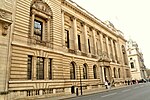Society for Earthquake and Civil Engineering Dynamics
The Society for Earthquake and Civil Engineering Dynamics (SECED) was founded in 1969 to promote the study and practice of earthquake engineering and structural dynamics, including blast, impact and other vibration problems. It also supports study of societal and economic ramifications of major earthquakes.It is the British branch of both the International Association (IAEE) and the European Association of Earthquake Engineering (EAEE). It is an Associated Society of the Institution of Civil Engineers (ICE), and is sponsored by the Institution of Mechanical Engineers (IMechE), the Institution of Structural Engineers (IStructE) and the Geological Society.SECED has organised conferences and lectures (see below). It hosted a 2002 European conference on earthquake engineering in London, and in July 2015 hosted a two-day conference at Homerton College, Cambridge titled Earthquake Risk and Engineering towards a Resilient World. It also organises regular meetings and has published a newsletter since 1987.
Excerpt from the Wikipedia article Society for Earthquake and Civil Engineering Dynamics (License: CC BY-SA 3.0, Authors).Society for Earthquake and Civil Engineering Dynamics
Great George Street, City of Westminster Millbank
Geographical coordinates (GPS) Address Nearby Places Show on map
Geographical coordinates (GPS)
| Latitude | Longitude |
|---|---|
| N 51.5011 ° | E -0.129 ° |
Address
Institution of Civil Engineers
Great George Street 1
SW1P 3AA City of Westminster, Millbank
England, United Kingdom
Open on Google Maps






